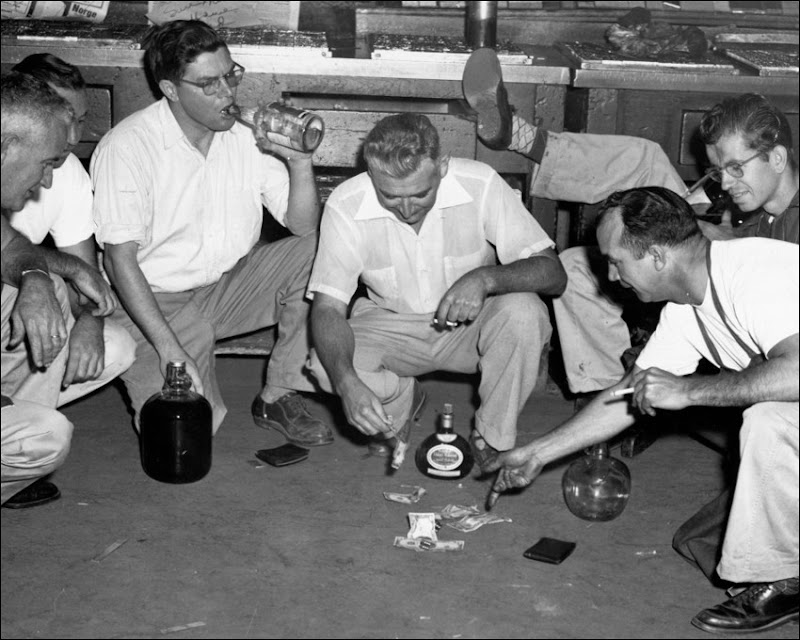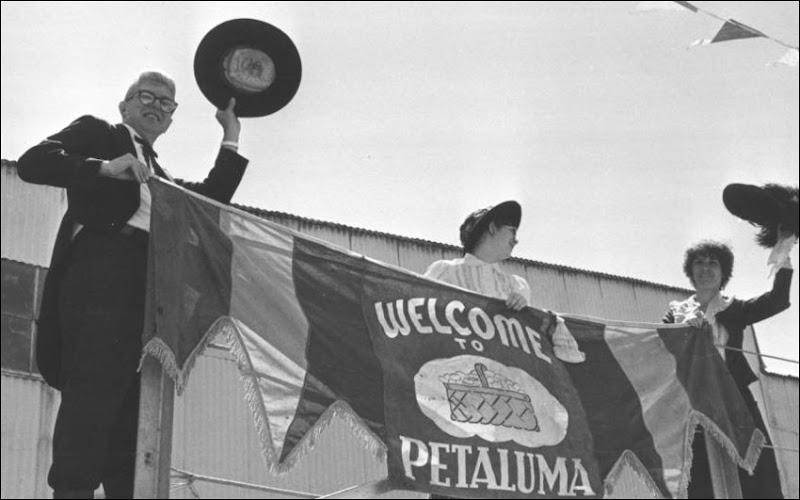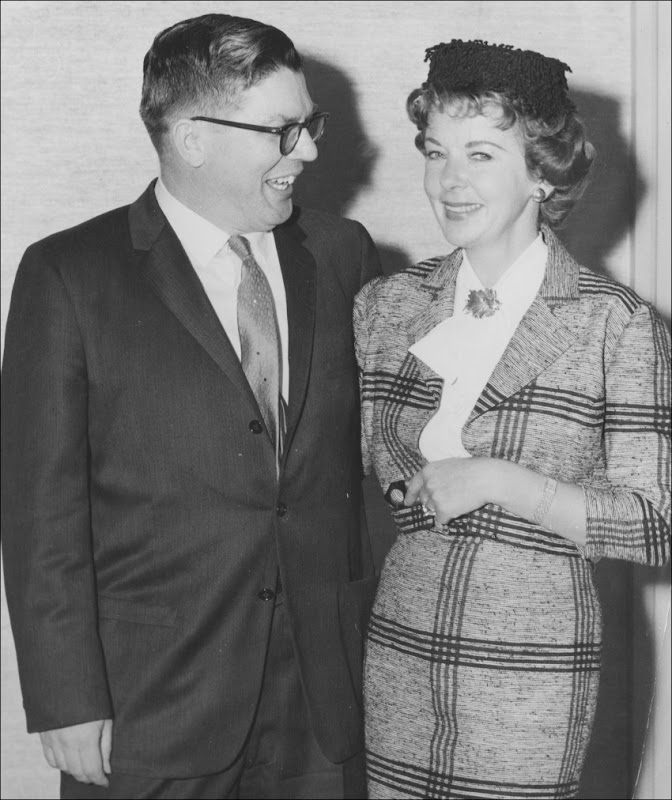Ask baby boomers who grew up in Santa Rosa what they miss from downtown: Chances are many will name the courthouse. Now climb into a time machine. Go back to the years those boomers were born and ask anyone working downtown what they wouldn’t miss if it were gone: Chances are most would name the courthouse.
In the mid-1950s downtown Santa Rosa was bustling, but not in a particularly healthy way. The population had grown by about 150 percent over the previous ten years1 and more people meant more businesses. But since this was also the Sonoma county seat, those retail stores or professional services were competing with city, county and state offices. Making matters worse, any available space was extremely tight because the downtown core still had the same footprint as the original tiny 1853 village as discussed in the intro to this series, “Yesterday is Just Around the Corner.”
As a result, government offices were mainly scattered between Third and Fifth streets with addresses subject to change. The county probation office was above the Topaz Room (Santa Rosa’s premier cocktail lounge) until it was moved to the Rosenberg building; you paid the water bill at the City Hall Annex before the Water Dept. was shuffled a block away to Third st. and the Annex – a small, one story building which was originally a gas station – became the Police Identification Bureau. Got all that? And this was just a small sample of the ongoing game of municipal musical chairs; when you see photos from that era with lots of people downtown, assume that a goodly portion are simply wandering about trying to find where the hell they’ve moved Parks & Rec.
But even before the population boom made matters so much worse, the courthouse was bursting at the seams from all the county offices housed in there. In 1945 they considered adding a third floor “penthouse on stilts” to the existing building, with most of the expense going to reinforce the structure. The solution settled upon in 1954 was to build a new county center (the present location) and migrate all administrative offices out there starting in 1956.2 By the year 1970, downtown Santa Rosa would only have the county jail and the courthouse which would still house the County Clerk, Tax Collector, and other offices that dealt with the public over a counter.
And then came the 1957 earthquake.
The March 22 quake was magnitude 5.5, which was the worst seen here since 1906. People were rattled but no one was injured and no buildings fell. The only damages reported at the courthouse initially were some fine paint cracks in one section of the building.
Then someone noticed the quake had “jiggled the overhanging cornice blocks a little farther out from the building,” according to the Press Democrat (They really meant the corbels underneath the cornice) and a contractor was hired to do a preliminary inspection.
County administrator Neal D. Smith told the PD the situation appeared “a lot worse than we thought,” and the contractor was afraid to touch them because it “might start a chain reaction” causing a hail of heavy, hard blocks, Smith added.
Smith continued by saying he was worried about the entire exterior veneer of the building, according to the paper. “We don’t know, frankly, what we’re getting into.”
Structural engineers from San Francisco were brought in and their report dropped the Supervisor’s jaws. Estimated cost of repairs was up to $452k – equivalent to over $4 million today. They found the corbels – which were only ornamental – were hollow and made of terra cotta so they weren’t very heavy, but they were attached to the building using tie wires, which were now badly rusted and wedged into holes held by wooden pegs that had rotted. Also, the 10-foot high concrete parapet wall above the cornice was generally in “poor condition,” was “apparently of low strength when built” and at risk of falling from its own weight as well as earthquake and high wind. Beyond that, they said further study was needed to see if the concrete in the building itself was similarly low grade and to see how well the pretty terra cotta cladding was attached to the concrete beneath.

Objectively it wasn’t really a terrible report, other than the decorative corbels had to be fixed or taken off. The big price tag was for stripping off all the terra cotta, bracing the underlying concrete and putting on modern ceramic cladding. If the county chose to simply do repairs the bill would be much smaller, as shown by the Supervisors approving an emergency $25,000 contract to have the corbels removed.
But that report was the camel’s nose; from that point onwards, the sad – and supposedly dangerous – condition of the courthouse became a recurring item on the Supervisor’s agenda and a running theme in the Press Democrat. The newspaper hyped the discovery of a ceiling crack in the Coroner’s office by noting it was directly below the “massive safe” in the treasurer’s office and new bracing was required because of the “questionably strong floors.” (Finalist in the competition for worst PD headline ever: “Engineers Find Many Bad Faults”.)
It’s important to understand the mindset of those times. The earthquake had left the town unnerved and learning that the courthouse may be in structurally “poor condition” was not reassuring to all those who worked there or just needed to do business there. Second: The new County Administration Center was still nearly a year away from having even the first building ready; should the courthouse be condemned as unsafe, there was no place to relocate all those many county employees.
Further complicating matters was another big issue which the Board of Supervisors was simultaneously grappling in the spring and summer of 1957: The creation of the county’s first set of uniform building codes. In one part of a meeting the discussion might be the politically hot potato of whether the new standards should be applied to older buildings that were being altered in some way – a scenario which would very much fit the courthouse. Later in the same meeting they might be wringing hands over the latest developments in the courthouse situation, particularly how far they should go with repairs. Petaluma’s Leigh Shoemaker was the first to say explicitly that it should be demolished, but all of the Supervisors joined in spitballing “what-if” scenarios about what should be done with Courthouse Square sans courthouse.3 Here was the first mention of splitting it in half with a roadway connecting Santa Rosa and Mendocino avenues.
More engineers were called in. This company drilled core samples and found the average strength of the concrete was around two-thirds of the minimum required in 1957 standards (the PD again pushed a negative angle, calling this “very low”). They also found that the huge slabs of terra cotta cladding were secured to the building in the same funky manner as the corbels – rusty tie wires held in place by dowels hammered into holes in the concrete wall. They reported there was a gap between 2-8 inches behind the terra cotta, but it was not explained whether that appeared to be caused by new slippage or how it was constructed.
Even the subpar concrete and discovery of the wall gap was not (yet) a death sentence for the courthouse. County administrator Smith told the Supes that for as little as $50k the terra cotta could be anchored to the back wall with the space between filled with an adhesive grout.4
And all was not bad news – addressing the earthquake safety risk, the final engineering report said the courthouse “is capable of withstanding only relatively minor earthquake shocks,” but cryptically added that like many similar buildings in the state, it “will no doubt remain in use for many years to come.” No, the building wasn’t up to modern building codes, but based on the average concrete strength found in the core samples it “just about” met the state’s standards for public buildings.
The year 1957 ended with the Board of Supervisors indecisive, agreeing only that the Fourth street scaffolding should be left standing and places where the terra cotta had been removed by the engineers should protected with plastic sheets until the end of the rainy season. It was expected that all of the cladding would come off the following year and the building would be covered in plaster.

Had all of this played out a year or two or three earlier, I have little doubt that the courthouse would have been repaired and preserved – that was, after all, the most economic route. At the start of 1958, four out of the five Supervisors agreed. But that was the year Santa Rosa caught a serious case of redevelopment fever and the Supes were not immune. Plus, they had a new prestigious consultant.
The recommendations from Ernst & Ernst were more radical than expected. Their experts guesstimated it would cost over one million dollars to rehabilitate the building; better to abandon it ASAP and sell Courthouse Square. (Hugh Codding had already made an offer of $350k – I’m sure Gentle Reader was waiting for him to pop up somewhere in this story about development, just as Alfred Hitchcock always made a cameo appearance in all of his movies.)
All hope of saving the courthouse was now dead, even though there was no clear path forward. The rest of the cladding was removed along with the parapet wall. The building was waterproofed and the scaffolding removed, leaving the once-beautiful building stripped down to its unlovely concrete bones.
Little happened for more than a year, but it was still desired to keep the courthouse near downtown. Santa Rosa’s newly formed Urban Renewal Agency (URA) had enormous powers to declare parts of the town “blighted” and had hired New Jersey architects to come up with an urban redesign that incorporated the courthouse and jail. A drawing of this plan can be found in the recent article about Santa Rosa Creek because the courthouse/jail were to be built on the south side of the waterway.
But the Supervisors – who had agreed to delay a decision for six months to give the URA a chance to present that plan – voted unanimously (with one abstention) to rebuild at the new County Administration Center instead. Now all they had to do was raise $3+ million to pay for it. The county put a bond measure on the ballot in 1960 and it was voted down. In 1961 they tried again and it was voted down. In 1962 it was voted down. Twice. In 1963 it was voted down. Methinks a pattern was beginning to emerge.
Meanwhile, it came to the attention of the State Division of Industrial Safety that people were still working and being held behind bars in those buildings, even though the county was no longer making improvements or doing needed maintenance. An investigation began just days before the first of the 1962 bond votes. The safety department’s report gave the county two months to submit an detailed schedule for making repairs or to evacuate both the jail and the courthouse. The Supervisors instead raised the county’s liability insurance by a million bucks.
The standoff intensified, with the state issuing still more fixit orders and the county appealing for delays until the next bond vote. Some of the repair demands were fairly trivial – move filing cabinets further apart so the weight wasn’t concentrated in one place – but others would have involved extensive work, such as rewiring parts of the courthouse so electrical office equipment would be grounded. The state had the Santa Rosa Fire Department do an inspection and the Fire Marshal found the courthouse to be an “extreme hazard.”
After the bond failed for the fifth time in 1963 the county finally gave up trying, and that summer a non-profit corporation was formed to provide funding (much to the ire of anti-tax activists).5 The Industrial Safety office stopped saber rattling.

And so we come to 1966 and the end of our tale, with the judges and clericals and supervisors all nestled snugly into their new digs at county central. It was time to knock down the courthouse.
There’s a story I’ve heard ever since I came to Sonoma county. Maybe you’ve come across it too; supposedly that old courthouse – which was supposed to fall down at the slightest earthquake – turned out to be so sturdy the company hired to demolish it went bankrupt trying to do the job. Welp, that story’s true. Sort of.
 (LEFT: The courthouse under construction in 1908. Image courtesy Sonoma County Library)
(LEFT: The courthouse under construction in 1908. Image courtesy Sonoma County Library)
A company called Bay Cities Excavators was hired and given 75 days to finish the job. Around day 18 the PD interviewed the wrecking-ball crane operator. “There’s a little more steel than I thought, but it doesn’t create too much of a problem,” adding that the courthouse would be down by the end of the following week. Had any of the workers bothered to look at the photos of the building when it was under construction they would have known there were tons and tons of steel inside that crumbly concrete – if anything, the structure had been overbuilt for strength.
 A week passes. Another month passes. Eight days from the deadline, the job still isn’t finished and the company has stopped work, claiming to have encountered a “sizable underground structure” which was unanticipated. (I’m guessing it was the old cesspool from the previous courthouse, a topic mentioned here earlier.) After the county whacked them on the nose with the rolled-up contract they continued work “under protest” and threatened to sue. Bay Cities Excavators likely lost money on the job but they didn’t go bankrupt and did several more projects in Santa Rosa over the following years.
A week passes. Another month passes. Eight days from the deadline, the job still isn’t finished and the company has stopped work, claiming to have encountered a “sizable underground structure” which was unanticipated. (I’m guessing it was the old cesspool from the previous courthouse, a topic mentioned here earlier.) After the county whacked them on the nose with the rolled-up contract they continued work “under protest” and threatened to sue. Bay Cities Excavators likely lost money on the job but they didn’t go bankrupt and did several more projects in Santa Rosa over the following years.
The same day demolition began, there was a ceremony where the county sold Courthouse Square to the city of Santa Rosa and its URA. That moment was long the fevered dream of developers; very soon half of it would be up for sale.
1 Santa Rosa population 1946: 14.9k (within city) 39.4k (metropolitan area). Santa Rosa population 1957: 32.5k (within city) 56.8k (metropolitan area). Source: Polk city directories |
2 The Recorder’s office was the first to move out of the courthouse to the County Administration Center in April, 1958. Strangely, the original 1953 plan called for the County Library to be relocated there as well. |
3 It was presumed in 1957 that Courthouse Square was county property, although the question of title would not be even addressed until 1963. |
4 Smith later mentioned using gunite on the building, which would have worked well to fill the gap between the concrete wall and the terra cotta cladding. |
5 Sonoma County Courthouse Inc. was founded to solicit about $5 million from private individuals to pay for the estimated $4.5 million cost of the building, which would be leased to the county for about $350k/mo for twenty years. |











